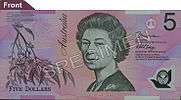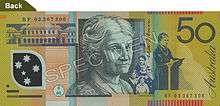Banknotes of the Australian dollar
The banknotes of the Australian dollar were first issued by the Reserve Bank of Australia on 14 February 1966, when Australia adopted decimal currency.[1] The $5 note was not issued until May 1967.[2]
Original series (papernote)
The $1 (10/-), $2 (£1), $10 (£5), and $20 (£10) had exact exchange rates with pounds and were a similar colour to the notes they replaced, but the $5 (£2/10) did not, and so was introduced after the public had become familiar with decimal currency. Notes issued between 1966 and 1973 bore the title "Commonwealth of Australia". Starting from 1974, the title on the new notes only read "Australia" and the legal tender phrase was also changed from "Legal Tender throughout the Commonwealth of Australia and the territories of the Commonwealth" to "This Australian Note is legal tender throughout Australia and its territories". The $50 note was introduced in 1973 and the $100 note in 1984, in response to inflation requiring larger denominations for transactions.[3] The one dollar note was replaced by a coin in 1984, while the two dollar note was replaced by a smaller coin in 1988.[3] These original bank notes were designed by Gordon Andrews, who rejected tradional Australian cliques for in favour for interesting and familiar subjects such as Aboriginal culture, women, the environment, architecture and aeronautics.[4] Although no longer printed, all previous issues of Australian dollar banknotes are considered legal tender.[5]
| Paper Series[6] | |||||||
|---|---|---|---|---|---|---|---|
| Image | Value | Dimensions | colours | Description | Date of circulation | ||
| Front | Back | Front | Back | ||||
| $1 | 140 × 70 mm | Brown and orange | Queen Elizabeth II | David Malangi (artwork) | 1966-1984 | ||
| $2 | 145 × 72.5 mm | Green and yellow | John Macarthur | William Farrer | 1966-1988 | ||
| $5 | 150 × 75 mm | Mauve | Sir Joseph Banks | Caroline Chisholm | 1967-1992 | ||
| $10 | 155 × 77.5 mm | Blue and orange | Francis Greenway | Henry Lawson | 1966-1993 | ||
| |
|
$20 | 160 × 80 mm | Red and yellow (orange backset) | Sir Charles Kingsford Smith | Lawrence Hargrave | 1966-1994 |
| |
|
$50 | 165 × 82.5 mm | Gold, blue, brown and green | Howard Florey, Baron Florey | Sir Ian Clunies Ross | 1973-1995 |
| |
|
$100 | 172 × 82.5 mm | Light blue and grey | Sir Douglas Mawson | John Tebbutt | 1984-1996 |
| These images are to scale at 0.7 pixels per millimetre. For table standards, see the banknote specification table. | |||||||
Second series (polymer)
In 1988, the Reserve Bank of Australia issued plastic, specifically polypropylene polymer banknotes (which were produced by Note Printing Australia), to commemorate the bicentenary of European settlement in Australia.[7] These notes contained a transparent "window" with a diffractive optically variable device (DOVD) image of Captain James Cook as a security feature. Australian banknotes were the first in the world to use such features.[7] All current Australian banknotes also contain Microprinting for further security.[8]
 |
 |
Third series (polymer)
There were initial difficulties with the first banknote issued; the $10 note (pictured above) had problems with the holographic security feature detaching from the note. However, the Reserve Bank saw potential in the issue of plastic banknotes and commenced preparations for an entirely new series made from polymer, commencing with the $5 note in 1992.[9] In April 1995, the design of the $5 note was updated[9] to match the rest of the New Note Series, with additional slight changes in 1996. In 2001, a special commemorative 'Federation' $5 note was produced,[10] but in 2002, the previous version's production commenced again.
From 2002, the design of all notes (except for the $5 note picturing the Queen) was slightly changed to include the names of the people pictured on them under the portraits, and swapping the order of the signatures of officials on the notes.
Today all Australian notes are made of polymer.
| Note | Obverse design | Reverse design | Dimensions4 (mm) | Weight4 (g) | Main colour | Window image | Embossing5 | Printed | Issued | ||
|---|---|---|---|---|---|---|---|---|---|---|---|
| $5 original1 | Queen Elizabeth II |
Parliament House, Old Parliament House |
130 × 65 × 0.1130 | 0.764 | Pale mauve[11] | Gum flower | N/A | 1992–1993 | 7 Jul 1992 | ||
| $5 recoloured |  Queen Elizabeth II |
 Parliament House, Old Parliament House |
130 × 65 × 0.1256 | 0.783 | Violet, pink | 1995-2016 | 24 April 1995 | ||||
| $5 Federation2 | .jpg) Sir Henry Parkes |
.jpg) Catherine Helen Spence |
130 × 65 × 0.1259 | 0.815 | Leaf shaped window | "5" | 2001 | 1 Jan 2001 | |||
| $103 |  Banjo Paterson |
 Dame Mary Gilmore |
137 × 65 × 0.1294 | 0.841 | Blue | Windmill | Wavy lines | Currently printing | 1 Nov 1993 | ||
| $20 |  Mary Reibey |
 Reverend John Flynn |
144 × 65 × 0.1332 | 0.900 | Red | Compass | "20" | Currently printing | 31 Oct 1994 | ||
| $50 |  David Unaipon |
 Edith Cowan |
151 × 65 × 0.1400 | 0.955 | Yellow | Southern Cross | "50" | Currently printing | 4 Oct 1995 | ||
| $100 |  Dame Nellie Melba |
 Sir John Monash |
158 × 65 × 0.1408 | 1.006 | Green | Lyrebird | "100" | Currently printing | 15 May 1996 | ||
| These images are to scale at 0.7 pixels per millimetre. For table standards, see the banknote specification table. | |||||||||||
| |||||||||||
Fourth Series (polymer)
On 13 February 2015 the Reserve Bank of Australia announced that the next series of Australia notes would have a tactile feature to help the visually impaired community to tell the value of the note after a successful campaign led by 15-year-old Connor McLeod, who is blind, to introduce the new feature.[12][13] The $5 banknote includes the tactile feature and was issued on 1 September 2016, to coincide with Australia's National Wattle Day.[14] Philip Lowe, the governor of the Reserve Bank, has said that the other fourth series banknotes will be released separately, anticipating that the $10 note will be released in 2017, followed by the $50 note, with the $20 and $100 notes unlikely to be released before 2018.[15]
| Note | Obverse design | Reverse design | Dimensions1 (mm) | Weight1 (g) | Main colour | Window image | Embossing4 | Printed | Issued | ||
|---|---|---|---|---|---|---|---|---|---|---|---|
| $5 Next Generation Banknote 2 | Queen Elizabeth II |
Parliament House |
130 × 65 × unknown | unknown | Violet, pink | Top to Bottom window 3 | "5" | Currently printing | September 1, 2016 | ||
| These images are to scale at 0.7 pixels per millimetre. For table standards, see the banknote specification table. | |||||||||||
| |||||||||||
See also
References
- ↑ "The Reserve Bank and Reform of the Currency: 1960–1988: Australia's First Decimal Banknotes". Reserve Bank of Australia Museum. Reserve Bank of Australia. Retrieved 31 December 2015.
- ↑ Linzmayer, Owen (2013). "Australia". The Banknote Book. San Francisco, CA: www.BanknoteNews.com.
- 1 2 "The Reserve Bank and Reform of the Currency: 1960–1988, Inflation and the Note Issue". Reserve Bank of Australia Museum. Reserve Bank of Australia. Retrieved 31 December 2015.
- ↑ Australia, Reserve Bank of. "The Designer: Gordon Andrews | The Decimal Revolution | Reserve Bank of Australia - Museum". Retrieved 2016-09-13.
- ↑ "DELIBERATE DAMAGE". Legal. Reserve Bank of Australia. Retrieved 9 February 2015.
All Australian banknotes, present and all past issues, are lawfully current in Australia.
- ↑ Renniks Australian Coin and Banknote Values
- 1 2 3 "Introducing Polymer Banknotes: A New Era". Reserve Bank of Australia Museum. Reserve Bank of Australia. Retrieved 31 December 2015.
- ↑ "List of Security Features". Counterfeit Detection. Reserve Bank of Australia. Retrieved 9 February 2015.
The security features that can be used to check a banknote are: Polymer Substrate ... Clear Window ... See-through Registration Device ... Shadow Image ... Intaglio Print ... Background Print (Offset) ... Micro-printing ... Fluorescent Ink
- 1 2 3 4 "A Complete Series of Polymer Banknotes: 1992-1996". Reserve Bank of Australia Museum. Reserve Bank of Australia. Retrieved 31 December 2015.
- ↑ "Banknotes in Circulation-$5 BANKNOTE". banknotes.rba.gov.au. Reserve Bank of Australia. Retrieved 9 February 2015.
- ↑ Ian W. Pitt, ed. (2000). Renniks Australian Coin and Banknote Values (19th ed.). Chippendale, NSW: Renniks Publications. p. 168. ISBN 0-9585574-4-6.
- ↑ "Next Generation Banknotes: Additional Feature for the Vision Impaired". www.rba.gov.au (Press release). Media Office-Reserve Bank of Australia. 13 February 2015. Retrieved 19 February 2015.
- ↑ Haxton, Nance (18 February 2015). "RBA to introduce tactile banknotes after 15yo blind boy Connor McLeod campaigns for change". Australian Broadcasting Corporation. Retrieved 19 February 2015.
- ↑ Next Generation of Banknotes: Issuance Date for the New $5 Banknote Reserve Bank of Australia (www.rba.gov.au). Retrieved on 2016-02-16.
- ↑ "A new $10 note is on its way". Business Insider Australia. Retrieved 22 September 2016.
External links
- Australian Decimal Banknotes australianstamp.com
- The Money Tracker site allows users to track Australian banknotes as they circulate around Australia.
- The Reserve Bank of Australia has a full timeline of Australian banknotes.